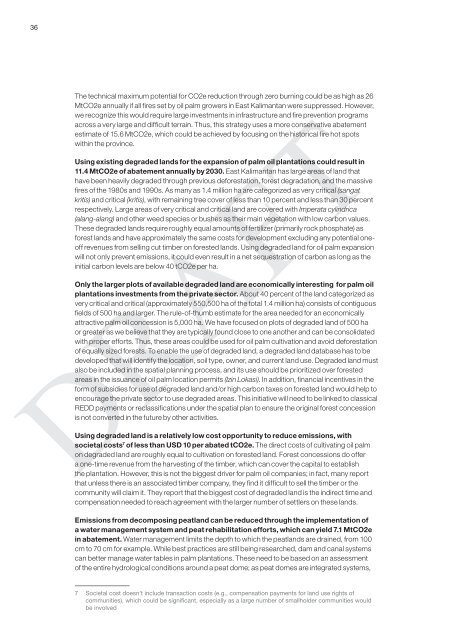East Kalimantan Environmentally Sustainable Development Strategy
East Kalimantan Environmentally Sustainable Development Strategy
East Kalimantan Environmentally Sustainable Development Strategy
Create successful ePaper yourself
Turn your PDF publications into a flip-book with our unique Google optimized e-Paper software.
36<br />
The technical maximum potential for CO2e reduction through zero burning could be as high as 26<br />
MtCO2e annually if all fires set by oil palm growers in <strong>East</strong> <strong>Kalimantan</strong> were suppressed. However,<br />
we recognize this would require large investments in infrastructure and fire prevention programs<br />
across a very large and difficult terrain. Thus, this strategy uses a more conservative abatement<br />
estimate of 15.6 MtCO2e, which could be achieved by focusing on the historical fire hot spots<br />
within the province.<br />
Using existing degraded lands for the expansion of palm oil plantations could result in<br />
11.4 MtCO2e of abatement annually by 2030. <strong>East</strong> <strong>Kalimantan</strong> has large areas of land that<br />
have been heavily degraded through previous deforestation, forest degradation, and the massive<br />
fires of the 1980s and 1990s. As many as 1.4 million ha are categorized as very critical (sangat<br />
kritis) and critical (kritis), with remaining tree cover of less than 10 percent and less than 30 percent<br />
respectively. Large areas of very critical and critical land are covered with Imperata cylindrica<br />
(alang-alang) and other weed species or bushes as their main vegetation with low carbon values.<br />
These degraded lands require roughly equal amounts of fertilizer (primarily rock phosphate) as<br />
forest lands and have approximately the same costs for development excluding any potential oneoff<br />
revenues from selling cut timber on forested lands. Using degraded land for oil palm expansion<br />
will not only prevent emissions, it could even result in a net sequestration of carbon as long as the<br />
initial carbon levels are below 40 tCO2e per ha.<br />
Only the larger plots of available degraded land are economically interesting for palm oil<br />
plantations investments from the private sector. About 40 percent of the land categorized as<br />
very critical and critical (approximately 550,500 ha of the total 1.4 million ha) consists of contiguous<br />
fields of 500 ha and larger. The rule-of-thumb estimate for the area needed for an economically<br />
attractive palm oil concession is 5,000 ha. We have focused on plots of degraded land of 500 ha<br />
or greater as we believe that they are typically found close to one another and can be consolidated<br />
with proper efforts. Thus, these areas could be used for oil palm cultivation and avoid deforestation<br />
of equally sized forests. To enable the use of degraded land, a degraded land database has to be<br />
developed that will identify the location, soil type, owner, and current land use. Degraded land must<br />
also be included in the spatial planning process, and its use should be prioritized over forested<br />
areas in the issuance of oil palm location permits (Izin Lokasi). In addition, financial incentives in the<br />
form of subsidies for use of degraded land and/or high carbon taxes on forested land would help to<br />
encourage the private sector to use degraded areas. This initiative will need to be linked to classical<br />
REDD payments or reclassifications under the spatial plan to ensure the original forest concession<br />
is not converted in the future by other activities.<br />
DRAFT<br />
Using degraded land is a relatively low cost opportunity to reduce emissions, with<br />
societal costs 7 of less than USD 10 per abated tCO2e. The direct costs of cultivating oil palm<br />
on degraded land are roughly equal to cultivation on forested land. Forest concessions do offer<br />
a one-time revenue from the harvesting of the timber, which can cover the capital to establish<br />
the plantation. However, this is not the biggest driver for palm oil companies; in fact, many report<br />
that unless there is an associated timber company, they find it difficult to sell the timber or the<br />
community will claim it. They report that the biggest cost of degraded land is the indirect time and<br />
compensation needed to reach agreement with the larger number of settlers on these lands.<br />
Emissions from decomposing peatland can be reduced through the implementation of<br />
a water management system and peat rehabilitation efforts, which can yield 7.1 MtCO2e<br />
in abatement. Water management limits the depth to which the peatlands are drained, from 100<br />
cm to 70 cm for example. While best practices are still being researched, dam and canal systems<br />
can better manage water tables in palm plantations. These need to be based on an assessment<br />
of the entire hydrological conditions around a peat dome; as peat domes are integrated systems,<br />
7 Societal cost doesn’t include transaction costs (e.g., compensation payments for land use rights of<br />
communities), which could be significant, especially as a large number of smallholder communities would<br />
be involved

















